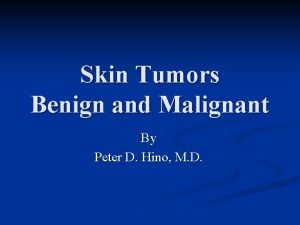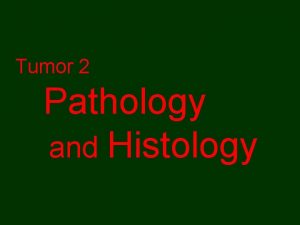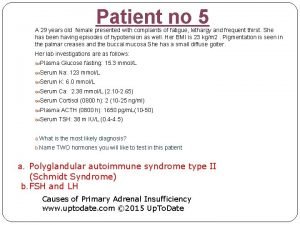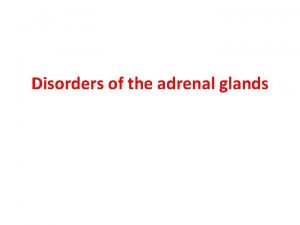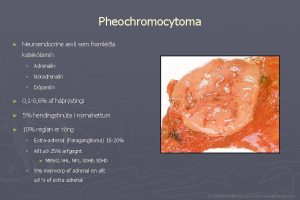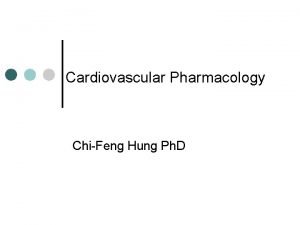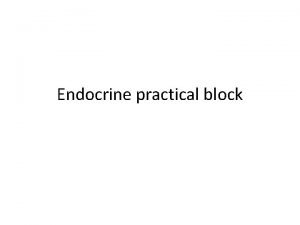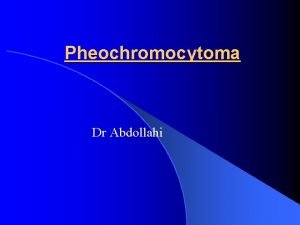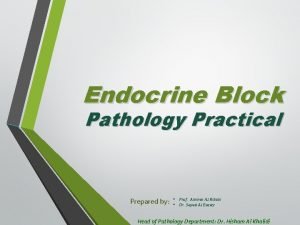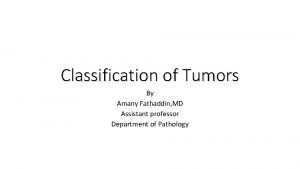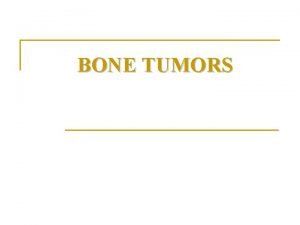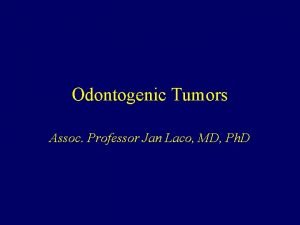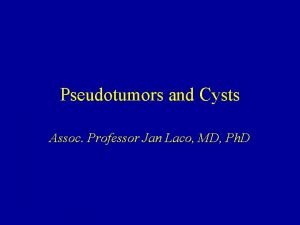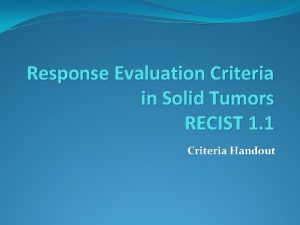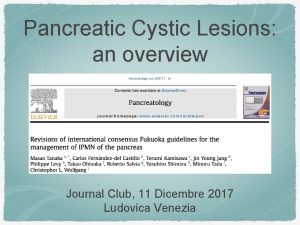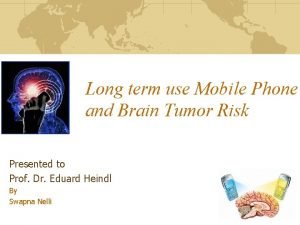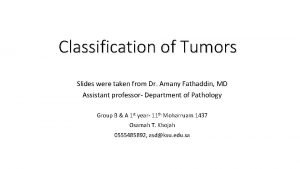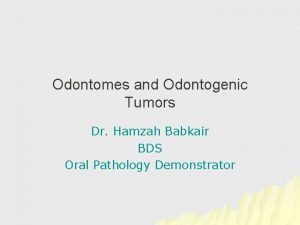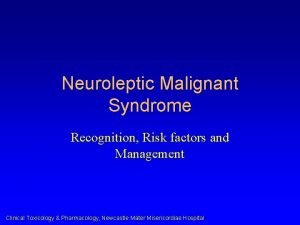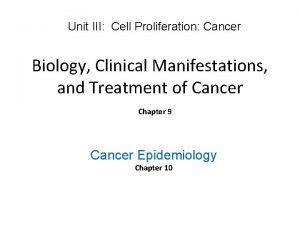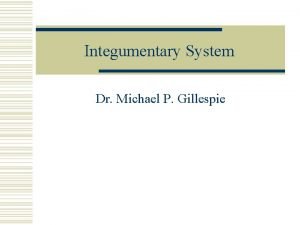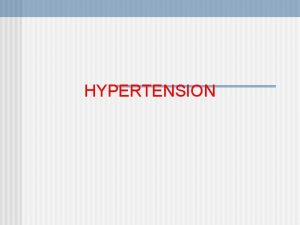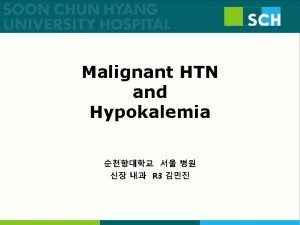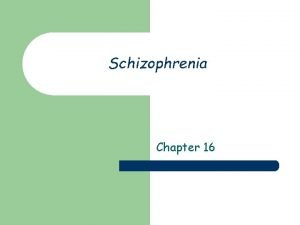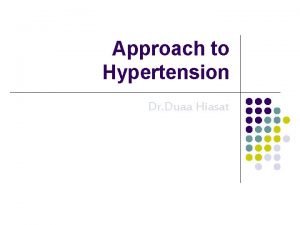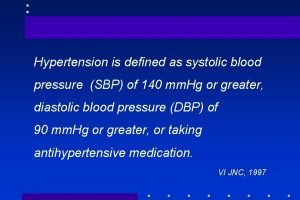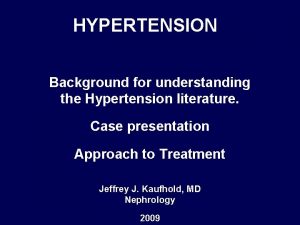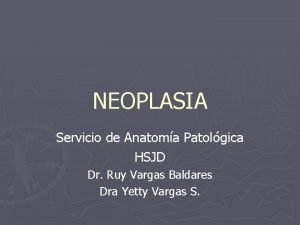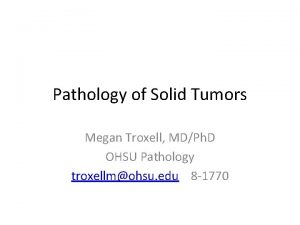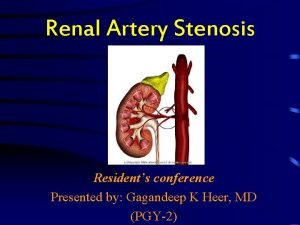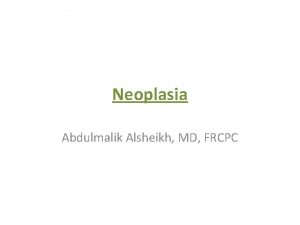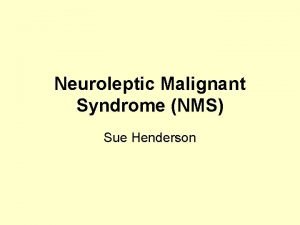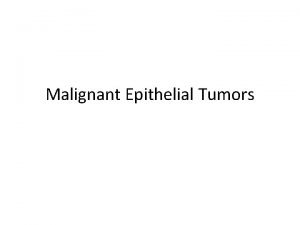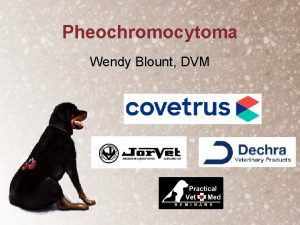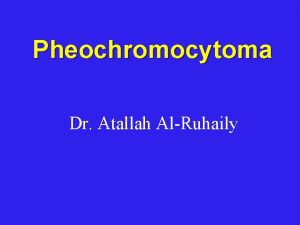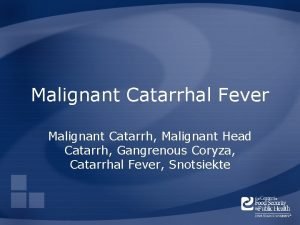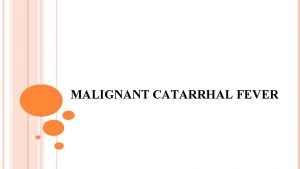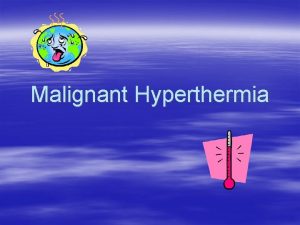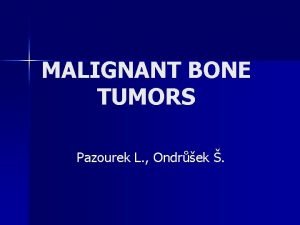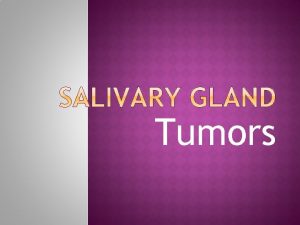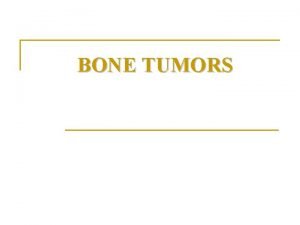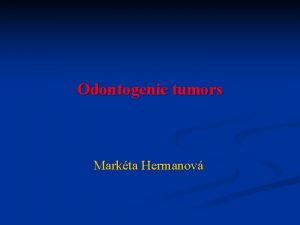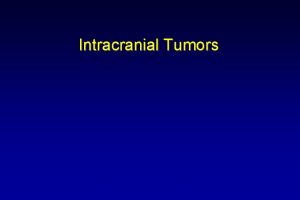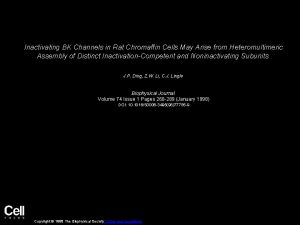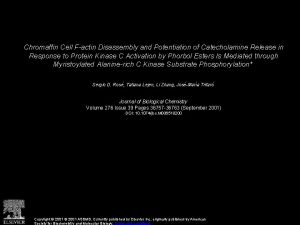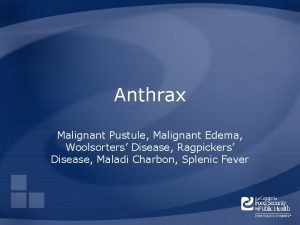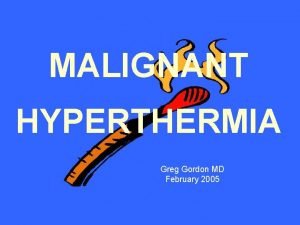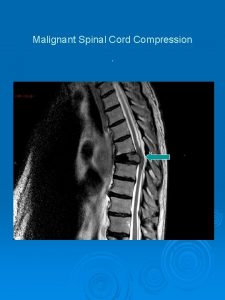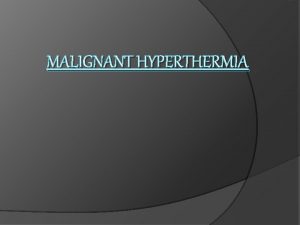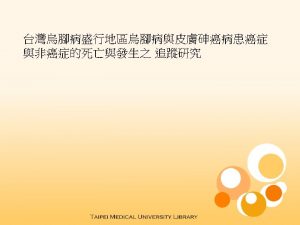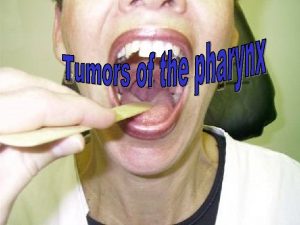Malignant pheochromocytoma Pheochromocytomas are tumors arising from chromaffin
























































![Conclusion: Sunitinib is associated with: Ø tumor size reduction Ø decreased [18 F]FDG-PET/CT uptake Conclusion: Sunitinib is associated with: Ø tumor size reduction Ø decreased [18 F]FDG-PET/CT uptake](https://slidetodoc.com/presentation_image/d3517325352b892256b63f841d4a1ede/image-57.jpg)
- Slides: 57

Malignant pheochromocytoma




Ø Pheochromocytomas are tumors arising from chromaffin cells, mainly of the adrenal gland, that synthesize, store, metabolize, and usually but not always secrete catecholamines. Ø prevalence of malignancy is commonly cited at about 10%, other estimates suggest rates of between 5– 26% depending on how malignancy is defined Endocrine-Related Cancer (2004) 11 423– 436

Ø Currently, there is no effective cure for malignant pheochromocytoma. Ø There also no reliable histopathological methods for distinguishing benign from malignant tumors. Ø malignancy requires evidence of metastases at nonchromaffin sites distant from that of the primary tumor. Ø Although extensive invasion of adjacent tissues can be considered an indicator of malignant potential, local invasiveness and malignant disease are not necessarily associated. Endocrine-Related Cancer (2004) 11 423– 436

Imaging Studies • We suggest CT rather than MRI as the firstchoice imaging modality because of its excellent spatial resolution for thorax, abdomen, and pelvis. (2+++○ ) • CT with contrast : sensitivity between 88 and 100%(nonionic contrast is safe) Pheochromocytoma and Paraganglioma: An Endocrine Society Clinical Practice Guideline. J Clin Endocrinol Metab, June 2014, 99(6): 1915– 1942

• We recommend MRI in: 1. patients with metastatic PPGLs 2. for detection of skull base and neck paragangliomas 3. surgical clips causing artifacts when using CT 4. allergy to CT contrast 5. radiation exposure should be limited (children, pregnant women, patients with known germline mutations, and those with recent excessive radiation exposure). (1+++○) Pheochromocytoma and Paraganglioma: An Endocrine Society Clinical Practice Guideline. J Clin Endocrinol Metab, June 2014, 99(6): 1915– 1942

We suggest the use of 123 I metaiodobenzylguanidine (MIBG) scintigraphy as a functional imaging modality: • in patients with metastatic PPGLs detected by other imaging modalities when radiotherapy using 131 I-MIBG is planned • occasionally in some patients with an increased risk for metastatic disease due to: Ø large size of the primary tumor Ø extra-adrenal, multifocal (except skull base and neck PPGLs), Ø recurrent disease. (2+○○○) Pheochromocytoma and Paraganglioma: An Endocrine Society Clinical Practice Guideline. J Clin Endocrinol Metab, June 2014, 99(6): 1915– 1942

Ø advantage of 123 I- over 131 I-labeled MIBG: ü better sensitivity ü its utility for imaging by SPECT. Ø up to 50% of normal adrenal glands demonstrate physiological uptake of 123 IMIBG, false positive results can be a problem. Ø Asymmetric uptake in normal adrenal glands can further lead to misinterpretation. Pheochromocytoma and Paraganglioma: An Endocrine Society Clinical Practice Guideline. J Clin Endocrinol Metab, June 2014, 99(6): 1915– 1942

123 I-MIBG for pheochromocytomas: v Sensitivity: ranges between 85 and 88% v specificity ranges from 70– 100% v Sensitivity for metastatic PPGLs: between 56 and 83% v Sensitivity for recurrent PPGLs: approximately 75% v Sensitivity for SDHx-related PPGLs: less than 50%). meta-analysis of 15 studies of 123 I-MIBG scintigraphy, sensitivity was 94% and specificity 92% Pheochromocytoma and Paraganglioma: An Endocrine Society Clinical Practice Guideline. J Clin Endocrinol Metab, June 2014, 99(6): 1915– 1942

Accumulation of 123 I-MIBG can be decreased by several drugs: 1) sympathomimetics 2) agents that block catecholamine transport via the norepinephrine transporter, such as cocaine and tricyclic antidepressants 3) calcium channel blockers and some combined - and adrenergic receptor blockers such as labetalol § Therefore, most of these drugs should be withheld for about 2 weeks before 123 I-MIBG scintigraphy. § Accumulation of 123 I-MIBG is also profoundly decreased in necrotic tumors.

Recommendation 2. 5 Wesuggest the use of 18 F-FDG PET/CT scanning in patients with metastatic disease. 18 F-FDG PET/CT is the preferred imaging modality over 123 I-MIBG scintigraphy in patients with known metastatic PPGLs. (2+++○) Sensitivity: between 74 and 100% highest performance for metastatic, particularly SDHB-related, PPGLs Pheochromocytoma and Paraganglioma: An Endocrine Society Clinical Practice Guideline. J Clin Endocrinol Metab, June 2014, 99(6): 1915– 1942

• We suggest measuring plasma or urine levels of metanephrines on follow-up to diagnose persistent disease. • We suggest lifelong annual biochemical testing to assess for recurrent or metastatic disease. (2++○○) • To document successful tumor removal, biochemical testing should be performed upon recovery of the patient from surgery (eg, 2– 4 wk after surgery). Pheochromocytoma and Paraganglioma: An Endocrine Society Clinical Practice Guideline. J Clin Endocrinol Metab, June 2014, 99(6): 1915– 1942

We recommend minimally invasive adrenalectomy • (eg, laparoscopic) for most adrenal pheochromocytomas. (1++○○) • We recommend open resection for large (eg, 6 cm) or invasive pheochromocytomas to ensure complete tumor resection, prevent tumor rupture, and avoid • local recurrence. (1+ ○○○) Pheochromocytoma and Paraganglioma: An Endocrine Society Clinical Practice Guideline. J Clin Endocrinol Metab, June 2014, 99(6): 1915– 1942


• The recurrence rate of pheochromocytoma after adrenalectomy is 6. 5– 16. 5% Ø local in the adrenal bed Ø distantly • Methods. retrospective analysis of 155 patients who underwent operation for adrenal pheochromocytoma at Cleveland Clinic from January 1, 2000, to July 31, 2013.

• Results: Eight patients (6%) developed recurrent disease. • The median time from initial operation to diagnosis of recurrence was 35 months. • On multivariate analysis, tumor size >5 cm was an independent predictor of recurrence.



Ø The optimal protocol, in our opinion, is measurement of metanephrines at 1, 6, and 12 months postoperatively and then annually thereafter. Ø Because up to 25% of our patients with recurrence had normal laboratory results with recurrence of disease, we also recommend annual cross-sectional imaging, preferably computed tomography, to look for recurrence. Ø Recurrence can occur many years after adrenalectomy, necessitating long-term monitoring.


• Patients with metastatic PCC/PGL have a 50% 5 year overall survival. Ø A retrospective analysis of 100 PCCs found that tumors with a PASS less than 4 were always clinically benign, whereas tumors with a PASS of 4 or more had the potential to become metastatic. Ø GAPP : classifying tumors as well differentiated (score: 0– 2), moderately differentiated (score: 3– 6), and poorly differentiated (score: 7– 10). •


• Treatments for Metastatic Pheochromocytomas and Paragangliomas: Ø full surgical resection Ø chemotherapy, 131 I-MIBG, and/or radiation can offer disease control. ü Given the often indolent nature of disease, therapies usually are reserved for patients with clear progression or severe symptoms. ü There are no studies to direct the timing or order of treatments. ü Alpha-blockade is required during any treatment to prevent hypertensive crisis from catecholamine release during tumor cell lysis.

Chemotherapy: Ø Cyclophosphamide, vincristine, and dacarbazine (CVD) chemotherapy is the standard regimen for treating metastatic PCC/PGL despite no prospective clinical trials. Ø systematic review and meta-analysis : v a complete or partial tumor response rate in 4% and 37% of patients, respectively v a complete or partial biochemical response rate of 14% and 40% of patients, respectively. Ø Of note, 14% of patients had stable disease. Ø Tumor responses usually occurred after 2 to 4 cycles of CVD therapy, and the median duration of response for the 2 studies that reported it was 20 months and 40 months. Ø The most common toxicities : v myelosuppression, peripheral neuropathy and gastrointestinal toxicity, (sometimes severe but usually transient)

123 I-Metaiodobenzylguanidine v. Sixty percent of PCCs/PGLs are MIBG avid, and therefore, are susceptible to systemic 131 IMIBG therapy. v. MIBG is transported into cells by the norepinephrine transporter and causes cell death by emitting ionizing radiation from the decaying 131 I radionuclide.

• A systematic review and meta-analysis: Ø total of 243 patients of varying ages who may or may not have had previous therapies and received 131 I-MIBG : § complete or partial tumor response in 3% and 27% of patients, respectively, § complete or partial hormonal response in 11% and 40% of patients, respectively. Ø Of note, 52% of patients had stable disease, but given the often indolent nature of metastatic PCC/PGL, it is unclear if this is due to treatment effects or the natural history of disease.

• Two studies within the cohort reported mean progression-free survival times of 23. 1 and 28. 5 months. • most commonly reported side effects: Ø toxicity with severe grade 3 to 4 neutropenia(87%) Ø thrombocytopenia (83%)

v. Free iodine from the treatment will accumulate in the thyroid gland; therefore, patients require potassium iodide before and after treatment to prevent a thyroiditis and subsequent hypothyroidism. v. Despite appropriate blockade, hypothyroidism can occur in 11% to 32% of patients.

Targeted Therapies • mammalian target of rapamycin (m. TOR) inhibitor everolimus: disappointing in this disease. • Sunitinib: Ø retrospective report of 17 patients with metastatic PCC/PGL. Ø There was a partial response (n = 3) or stable disease (n = 4) in 47% of patients. Ø The median progression-free survival was only 4. 1 months.

External Beam Radiotherapy Ø controversial Ø Malignant PCCs/PGLs were believed to be resistant to radiation, but recent work suggests that EBRT can affect long-term local control in most cases. Ø The largest retrospective cohort examined EBRT in 24 patients with metastatic PCC/ PGL : v. Symptomatic control or stable disease by imaging was seen in 81% and 87% of the lesions, respectively.

Ø retrospective review of 17 patients with non–head and neck malignant PCC/PGL treated with various EBRT regimens to a median dose of 40 Gy: v Seventy-six percent of patients had local control (attributable to disease stabilization and/or symptom control). • EBRT appears to offer symptomatic control in patients with limited burden of metastases. • Because metastatic PCC/PGL can be an indolent disease, prospective studies are needed to determine if EBRT truly contributes to disease stability in terms of tumor growth.


• MPPs are defined by their endocrine tumor morphology and positive immunohistochemical staining for chromogranin. A and synaptophysin; negative staining for keratins allows MPPs to be differentiated from the metastases of gastroenteropancreatic NETs

Ø Patients with pheochromocytomas: vlarger than 5 cm vparagangliomas of any size vand/or carriers of SDHB mutations Ø need radiographic studies that can detect metastases in the thoracic, abdominal, and pelvic cavities and the skeletal tissue or recurrences in the primary tumor bed. • The usual sites of metastatic involvement: • lymph nodes (80%), bones (71%), liver (50%), and lungs (50%)

Treatment Surgery may be considered to: vrelieve the compression of neurological structures vresect the primary tumors vif other approaches fail to remove them, resect macroscopic tumors.

MIBG therapy:

Ø Differences in MIBG activity, endpoints, and imaging modalities and insufficient clinical characterization of MPP patients make it impossible to compare these studies. vtumor responses : range from 22 to 48%. vbiochemical response: 35– 67% Ø Main safety issues : asthenia, nausea, vomiting, hematologic and thyroid dysfunction Ø to a lesser extent: second cancer, hypertensive crisis, sepsis, and pulmonary toxicity.

• Patient deaths have also been reported (mainly due to bone marrow insufficiency/dysplasia). • The ideal candidates for MIBG therapy as a first-line therapy are patients with: Ø significant tumor burden Ø slowly progressive disease Ø adequate MIBG uptake on diagnostic imaging Ø acceptable blood tests (absolute neutrophil count ≥ 1500/mm 3, platelet count ≥ 100 000/mm 3, hemoglobin levels ≥ 9 g/dl, bilirubin levels ≤ 1. 5×the upper limit of normal (ULN), serum albumin levels ≥ 2. 8 g/dl, serum creatinine levels ≤ 1. 5×ULN, and alanine aminotransferase and aspartate aminotransferase levels ≤ 3. 0×ULN), and good performance status.

v Experience using 90 Y-DOTATOC and 177 Lu- DOTATOC, the two most often used radiolabeled agents that target somatostatin receptors, for targeted radiotherapy in MPP patients is limited. v Two studies have shown that targeted radiotherapy with these agents elicits response rates of <10% v This contrasts with the higher sensitivity of somatostatin receptor scintigraphy as a diagnostic imaging study compared with MIBG scintigraphy. v The inappropriate expression of somatostatin receptor subtypes in MPP cells or processing errors may explain the lack of response to octreotide

Chemotherapy : v In the first study carried out by Averbuch et al. the CVD regimen elicited partial or complete responses in 10 (55%) of the 18 patients. v Patel et al. reported that a modified CVD regimen that included the optional use of vincristine combined with doxorubicin elicited a similar partial response rate (46%) in 13 MPP patients. v Recently, a group from the MD Anderson Cancer Center has reported a 25% objective response rate using cyclophosphamide and dacarbazine and the optional use of vincristine or doxorubicin in 52 MPP patients. v In a recent report from Japan, 8 (47%) of the 17 evaluable MPP patients who received CVD therapy exhibited a complete or partial biochemical and/or tumor response. v However, variations in endpoints and imaging modalities and insufficient patient characterization make comparing these studies impossible. v No single prospective study has confirmed the results of any of these studies.


Ø One alternative to the CVD regimen may be temozolomide, a 3 -methyl analog of mitozolomide that was developed as an oral alternative to i. v. dacarbazine Ø less toxicity than the CVD regimen • Recent reports: vresponse rates of MPP patients on temozolomide therapy are similar to those on the CVD regimen. v. Median progression-free survival was longer in SDHB mutation carriers (19. 7 months) compared with non-mutation carriers (2. 9 months) (P =. 007).

Ø Ideal candidates for the use of chemotherapy as a first-line therapy are: vrapidly progressive and/or symptomatic disease and adequate performance status and blood tests vfor patients with multiple bone metastases, chemotherapy may have less toxicity compared with radiopharmaceutical agents.

Molecular targeted therapies Ø In three different series, 11 patients treated with everolimus and two patients receiving imatinib exhibited no response to targeted therapy. Ø another study reported that one of three patients exhibited an objective response to thalidomide, an antiangiogenic agent, combined with oral dacarbazine. Ø Case reports have described objective responses to sunitinib with manageable toxicity in a few MPP patients. Ø More importantly, two large cancer referral centers’ combined experience in treating 17 patients who had rapidly progressive MPPs with sunitinib revealed that 21 and 54% of these patients exhibited responses based on the Response Evaluation Criteria in Solid Tumors or FDGPET findings respectively. Ø In addition, 43% blood pressure under control, and some of them discontinue antihypertensive medications.


131 I-MIBG Therapy of Adult Neuroendocrine Tumors 131 I-MIBG has been successfully used for: advanced neuroendocrine tumors (NET) of the adult : Ø Pheochromocytoma and paraganglioma (Pheo) Ø gastroenteropancreatic NET, predominantly in carcinoid tumors of the enterochromaffin (EC) cell type Ø less frequently in medullary thyroid carcinoma (MTC)

Results in Pheochromocytoma and Paraganglioma: • The typical indication : vmultilocular or disseminated metastatic disease with no curative—ie, surgicaltreatment option. • Tumor progression and/or uncontrollable function should be present when applying an aggressive treatment approach such as 131 IMIBG.

• The response rates are ranging between 30% and 47% for morphologic response and 75%-90% for symptomatic response. • Biochemical response is usually less frequently seen than profound symptomatic relief, similar to the observations made in carcinoid tumors.

Ø Safford et al found a survival benefit for patients treated with higher initial doses of 131 I-MIBG, that is, 400 -500 m. Ci, and concluded to use 500 m. Ci as the routine initial dose in metastatic pheochromocytoma. Ø university center from San Francisco: v. Their treatment schedule of single doses between 500 and 1200 m. Ci (median 12 m. Ci/kg), administered after peripheral stem-cell collection, achieved solid tumor response rates in a prospective study setting and most notably a high survival rate. Ø toxicity—not only hematologic should be considered.


Objectives: The primary end point was: progression-free survival determined by RECIST 1. 1 criteria or positron emission tomography with [18 F]fluorodeoxyglucose/computed tomography ([18 F]FDGPET/CT) Secondary endpoints were: tumor response according to RECIST criteria version 1. 1 or FDG uptake, blood pressure control, and safety.

Design: • retrospective review of medical records of patients with metastatic PHEO/SPGL treated with sunitinib from December 2007 through December 2011. • Most patients were initially given sunitinib 50 mg/d, 4 wk on and 2 wk off. In some of these patients, to mitigate side effects, the dosage of sunitinib was later decreased at the discretion of the treating clinician to 37. 5 mg/d, continuously or 3 wk on and 1 wk off. • Three patients were initially given sunitinib 37. 5 mg/d continuously.


Results: • According to RECIST 1. 1, eight patients experienced clinical benefit; three experienced partial response, and five had stable disease, including four with predominant skeletal metastases that showed a 30% or greater reduction in glucose uptake on [18 F]FDG-PET/CT. • Of 14 patients who had hypertension, six became normotensive and two discontinued antihypertensives. • One patient treated with sunitinib and rapamycin experienced a durable benefit beyond 36 months. • The median overall survival from the time sunitinib was initiated was 26. 7 months with a progression-free survival of 4. 1 months (95% confidence interval 1. 4 – 11. 0). • Most patients who experienced a clinical benefit were carriers of SDHB mutations.
![Conclusion Sunitinib is associated with Ø tumor size reduction Ø decreased 18 FFDGPETCT uptake Conclusion: Sunitinib is associated with: Ø tumor size reduction Ø decreased [18 F]FDG-PET/CT uptake](https://slidetodoc.com/presentation_image/d3517325352b892256b63f841d4a1ede/image-57.jpg)
Conclusion: Sunitinib is associated with: Ø tumor size reduction Ø decreased [18 F]FDG-PET/CT uptake Ø disease stabilization Ø hypertension improvement in some patients with progressive metastatic PHEO/PGL. v. Prospective multi-institutional clinical trials are needed to determine the true benefits of sunitinib.
 Peter hino md
Peter hino md Liposarcoma
Liposarcoma Adrenal nervous system
Adrenal nervous system Antigentest åre
Antigentest åre Bartter syndrome mnemonic
Bartter syndrome mnemonic Rule of 10 in pheochromocytoma
Rule of 10 in pheochromocytoma Pheochromocytoma
Pheochromocytoma Panaldin
Panaldin Pheochromocytoma triad
Pheochromocytoma triad Pheochromocytoma
Pheochromocytoma Pheochromocytoma triad
Pheochromocytoma triad Graves disease
Graves disease Classification of tumors
Classification of tumors Cervical ectropion
Cervical ectropion How many bones
How many bones Ameloblastoma rtg
Ameloblastoma rtg Paresthiasis
Paresthiasis Odontogenic tumors classification
Odontogenic tumors classification Spinal cord
Spinal cord Response evaluation criteria in solid tumors (recist)
Response evaluation criteria in solid tumors (recist) Thyroid tumors
Thyroid tumors Exocrine tumors of pancreas
Exocrine tumors of pancreas Enneking classification
Enneking classification Mobile phone brain tumour
Mobile phone brain tumour Classification of tumors
Classification of tumors Teratoma
Teratoma Codman üçgeni
Codman üçgeni Odontogenic tumors
Odontogenic tumors Chest wall tumors
Chest wall tumors Changes in an individual's behavior arising from experience
Changes in an individual's behavior arising from experience Consumer markets and consumer buyer behavior
Consumer markets and consumer buyer behavior Reinforcement schedule types
Reinforcement schedule types Changes in an individual's behavior arising from experience
Changes in an individual's behavior arising from experience Analyzing consumer markets
Analyzing consumer markets Behavioural segmentation example
Behavioural segmentation example Neuroleptic malignant syndrome
Neuroleptic malignant syndrome Benign and malignant tumor difference
Benign and malignant tumor difference Malignant mesothelioma
Malignant mesothelioma Nail body
Nail body Malignant hypertension ppt
Malignant hypertension ppt Hypertensive encephalopathy
Hypertensive encephalopathy Neuroleptic malignant syndrome mnemonic
Neuroleptic malignant syndrome mnemonic Malignant hypertension management
Malignant hypertension management Calcium channel blockers examples
Calcium channel blockers examples Hypertensive emergency vs urgency
Hypertensive emergency vs urgency Perdida de polaridad celular
Perdida de polaridad celular Benign vs malignant
Benign vs malignant Hypertensive emergency definition
Hypertensive emergency definition Kitwood malignant social psychology
Kitwood malignant social psychology Md frcpc definition
Md frcpc definition Malignant neoplasm of the blood-forming organs
Malignant neoplasm of the blood-forming organs Malignant neuroleptic syndrome
Malignant neuroleptic syndrome Histological features of malignant cells
Histological features of malignant cells
